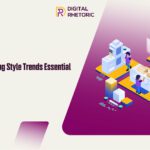Leading Online Advertising Trends for 2024
- Sanjay Thakore
- May 18, 2024
- Blog
- 0 Comments

As we step into the future of advertising, it’s clear that advertising in 2024 will be shaped by dynamic online advertising trends. From AI-driven personalization to ethical marketing practices, these developments promise to redefine how brands connect with consumers in an increasingly digital world.
Rise of AI and Machine Learning
Digital advertising trends in 2024 are heavily influenced by AI, revolutionizing online advertising strategies with unprecedented personalization and efficiency in ad targeting. This integration of advanced algorithms allows marketers to tailor messages precisely to individual user preferences and behaviours, significantly enhancing engagement and conversion rates.
- Persado: Utilizes AI to craft emotionally resonant messaging that boosts engagement and conversions.
- Albert AI: An AI-driven platform that automates and optimizes ad content creation and media buying.
- Pencil: Generates dynamic video and image ads that learn and evolve based on user interaction and feedback.
- Phrasee: Specializes in using AI to produce language for email marketing, push notifications, and social media that resonates with specific audience segments.
- Celtra: Offers a creative management platform that uses AI to design and scale personalized advertising content across multiple channels.
Voice and Visual Search Optimization
Advertising in 2024, quickly moves towards the future of advertising, optimizing for voice searches, as smart speakers get installed in every room. At the same time, the sunrise of online advertising trends involves visual search, allowing brands to take advantage of both visual and augmented reality-based advertising. These aspects are vital for reaching out to tech-savvy customers and making their shopping journey more interactive.
Interactive and Shoppable Ads
The digital advertising trends are changing fast. Interactive ads are dominating, getting users to engage by playing quizzes, taking polls, and playing simple games right inside an ad. Digital marketing allows creatives to capture attention while users engage and collect their online behaviour. In terms of shoppable ads, consumers can now buy a product straight from the ad and no longer have to waste any time going through checkout. These interactive online advertising strategies are much different from how consumers encounter brands.
Privacy-First Advertising
Tougher privacy laws and the cookie ban have had a significant detrimental effect on ad targeting, leading to online advertising approaches that are evolving. Brands are leveraging first-party data and doubling down on transparency and the importance of people’s approval. In addition to fostering consumers’ trust and generating consent, and pioneers such as contextual targeting and privacy-protecting machine learning models, there are novel methods to deliver personalized experiences without encroaching on user privacy.
Sustainability and Ethical Advertising
Consumer interest in sustainability is growing at a rapid pace, leading brands to include eco-friendly messages in their marketing strategies. As a result, ethical advertising is taking centre stage due to the exposure, honesty, and integrity of a brand’s message being spread. Some of the advertisements are based on reformatted materials and transparent communication intending to show concern for the environment or human rights, which resonate well with conscious eco-consumers. In turn, it fosters brand trustworthiness and brand loyalty in the long term.
Use of Augmented Reality (AR) and Virtual Reality (VR)
Advertising is becoming more immersive through Augmented Reality and Virtual Reality. Today, advertisers use these technologies for dynamic showcases, “touching” consumers’ hands, virtual shopping with a 3D fitting, and showrooms that pull into the screen or the real world during a video call. The most interesting thing is that this does not simply attract but it also increases the depth of understanding and interest in products, maximizing interaction and conversion.
- Fashion: Virtual fitting rooms where customers try on clothes using AR to see how outfits look without physically changing.
- Real Estate: VR tours that allow potential buyers to walk through properties remotely, experiencing the space from their own homes.
- Automotive: AR apps that overlay car features and modifications onto existing vehicles, helping customers visualize customizations before purchase.
Influencer Collaboration and User-Generated Content
The influencer partnership trend is developing. It provides brands with an opportunity to communicate with the audience through authentic and relatable content. Secondly, the development of campaigns with UGC is creating a sense of community and trust. Such strategies use IRL voices and experiences, which increases the trust and relationship between brands and customers.
Programmatic Advertising
Programmatic advertising has made immense progress with real-time, highly accurate purchasing and ad placement. Modern technology has already incorporated some of the most advanced algorithms to process enormous volumes of data to make an accurate assumption, target the appropriate audience, and make adjustments as per user responsiveness, and measures of engagement, with unbelievable accuracy in no time. Such features guaranteed marketers that their advertisements would be ten times more relevant, which significantly impacted their goals and resulted in unbelievable financing in terms of return on investment.
Video Advertising
The success of video advertising remains unparalleled, short-form videos stand out such as those on TikTok and Instagram. These quick, snappy video clips are the perfect fit for the shortening attention spans of the screens, they offer a dynamic method through which to captivate interest and communicate a marketing message quickly. The potential for virality is another advantage of such forums, which allows for advertising with worldwide reach and engagement.
- 360-Degree Videos: Allowing viewers to control their perspective for a more immersive experience.
- Interactive Hotspots: Enabling users to click on parts of the video to learn more or visit a product page directly.
- Live Streaming Ads: Incorporating real-time viewer interactions and instant purchases within live broadcasts.
- Vertical Videos: Optimized for mobile viewing, leveraging the full screen of smartphones for greater impact.
- Choose Your Own Adventure: Videos where viewers can make decisions that influence the story or outcome, enhancing engagement.
Localization and Geo-Targeting
There is a need for local ad campaigns as this ensures that the adverts resonate more with the locals due to the fact that they are made with the local cultural and linguistic pathways in mind. There are also advances in geo-targeting that ensure the advertisers reach the people they target with the ads more closely than ever. Using more sophisticated location data, brands can come up with ads that represent the tastes and habits of their consumers, which significantly increases the relevance and impact of the ads.
Conclusion
Discover the world behind the future of digital marketing and be part of the first wave! Take advantage of our cutting-edge analysis and expert opinion on the likely trajectory of internet commercials. Unleash the maximum potential of your brand – log on to https://digitalrhetoric.in/ now! Let’s effectuate your advertising strategies online for that magical experience. Flip the script on digital marketing!

